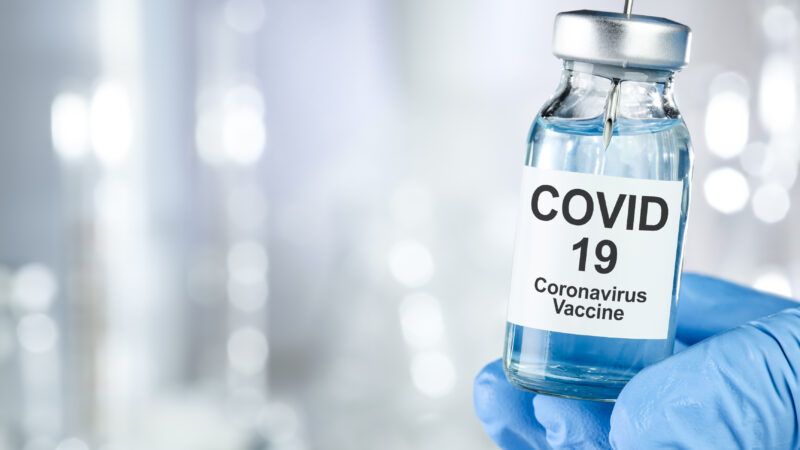COVID-19 Herd Immunity Is Possible Before Spring If the FDA Gets Out of the Way
The government must move quickly to approve a one-dose regimen for Pfizer/BioNTech and Moderna vaccines.

Twenty million Americans will not be vaccinated by the end of this year as promised by the federal government. According to the Centers for Disease Control and Prevention (CDC) just over 2.1 million Americans have received the first dose COVID-19 vaccines and nearly 11.5 million doses have been distributed. That number is tens of millions fewer vaccinated people than is needed to reach the herd immunity threshold that would effectively stop the pandemic.
Herd immunity is the resistance to the spread of a contagious disease that results if a sufficiently high proportion of a population is immune to the illness. Some people are still susceptible, but they are surrounded by immune individuals who serve as a barrier, preventing the microbes from reaching them. Epidemiologists typically estimate that the COVID-19 threshold for herd immunity is around 60 to 70 percent.
Independent data scientist Youyang Gu over at the COVID-19 Projections website takes a heavily caveated but informative stab at calculating when the U.S. might achieve herd immunity to the coronavirus in the next year. The upshot: "We estimate COVID-19 herd immunity (>60% of population immune) will be reached in the US during summer 2021 (Jun-Aug 2021)." Achieving that goal means that approximately 200 million Americans will be immune to the virus by summer. Let's take a look at how Gu and his colleagues navigate the pathway to COVID-19 herd immunity in the U.S.
Interestingly, Gu estimates that roughly half of herd immunity will be achieved through natural infection, that is, he calculates that around 105 million Americans will have been infected before the end of 2021, most of them by April. That's up from an estimated 66 million infected as of mid-December. As a result of the additional infections, the final death toll from the disease will rise to around 500,000 people. For context, diagnosed cases are just over 19 million with 332,000 deaths so far.
Unfortunately Gu expects that the U.S. vaccine campaign's slow start will result in only 2 percent of Americans gaining full two-dose vaccine immunity by the end of January. Less pessimistically, he estimates that 25 million Americans will have gotten at least the first dose of a COVID-19 vaccine by the end of January. One of Gu's big caveats is that he only counts the immunity that was acquired first (e.g., if an individual has both immunity from natural infection and immunity from vaccination, Gu only counts the immunity from infection). Basically, lot of people who have become immune due to having been previously infected (many asymptomatic) will also end up being vaccinated.
As more Americans get vaccinated, Gu projects that the rate of daily COVID-19 infections will begin a steep decline in April. Consequently, his best estimate of a complete "return to normal" in the U.S. is mid-summer 2021 (June/July). He defines "normality" as the removal of all COVID-19-related restrictions and interventions.
However, Gu suggests that there is a way for the U.S. to reach the herd immunity threshold of 60 percent as early as March. How? Since one-dose of both the Pfizer/BioNTech and Moderna vaccines are nearly 90 percent effective, just give each person one-dose instead of requiring two. The problem is that hyper-cautious Food and Drug Administration regulators are unlikely to risk taking this step. In addition, Gu suggests prioritizing people for vaccination who have not already been infected.
Another big caveat is that Gu's calculations take into account just the rollout of the two currently approved vaccines. He notes if additional vaccines—such as those developed by AstraZeneca and Johnson & Johnson—become available in early 2021 that will increase vaccine uptake, thus speeding up the process of reaching herd immunity.
According to recent news reports, AstraZeneca CEO Pascal Soriot believes that his company has worked out a dosing formula that boosts its two-dose virus-vector vaccine to around 90 percent efficacy at preventing COVID-19 infections. The U.K. is reportedly on the verge of approving it for distribution as early as this week. The U.S. government has agreed to purchase as many 300 million doses of the AstraZeneca vaccine. If the data from Johnson & Johnson's clinical trial for its one-dose virus-vector vaccine shows that it provides significant protection against COVID-19, it could be approved before the end of January. The company has contracted with the federal government to provide 100 million doses of its vaccine.
If government regulators cut through bureaucratic red tape, the U.S. would have a good chance to essentially end the pandemic before spring. Will they? Probably not.
Show Comments (107)